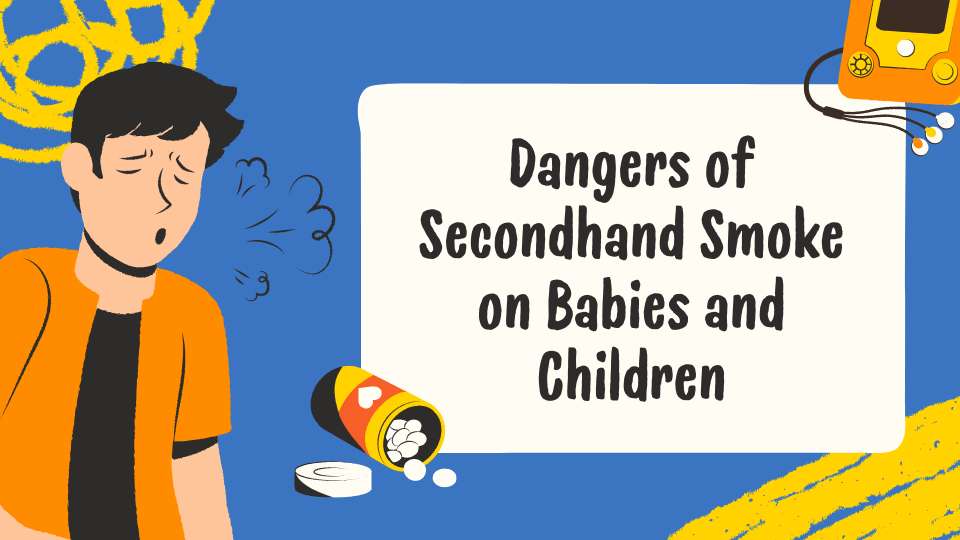Secondhand smoke is a combination of the smoke from the lighted end of a cigar, pipe, or cigarette and the smoke exhaled by the smoker. This is also called Environmental Tobacco Smoke (ETS). Secondhand smoke has a serious impact on health and is recognized as a known cancer-causing agent.

Many women stop smoking after getting pregnant, but they forget the fact that they have to protect their baby from secondhand smoke. Secondhand smoke that fills the air from other people’s cigarettes is also dangerous for your baby. In fact, studies have shown that children exposed to secondhand smoke are more likely to develop health issues later in life.
Health Risks for Pregnant Women Exposed to Secondhand Smoke
Pregnant women who get exposed to cigarette smoke have a higher risk of experiencing complications, including:
- Getting colds and headaches
- More difficult delivery
- Giving birth to a smaller than average baby
- Having a sick baby who cries a lot
Recent research has revealed that pregnant women exposed to secondhand smoke are 25% more likely to have low birth weight babies. Additionally, exposure during pregnancy can increase the risk of preterm birth by about 20%, leading to serious health complications for the baby.
| Risk | Impact on Pregnancy |
|---|---|
| Low Birth Weight | 25% more likely with secondhand smoke exposure |
| Preterm Birth | 20% higher risk with secondhand smoke exposure |
| Respiratory Issues | Increased chances of developing colds and respiratory issues |
Impact of Secondhand Smoke on Babies
For your baby, exposure to secondhand smoke:
- Makes it hard to breathe
- Causes the eyes to sting
- Increases the chances of getting colds, ear infections, bronchitis, and pneumonia
- Puts them at risk for Sudden Infant Death Syndrome (SIDS)
SIDS, a sudden and unexplained death of an otherwise healthy infant, is linked to secondhand smoke exposure. Babies exposed to secondhand smoke are up to three times more likely to die from SIDS, underlining the critical importance of keeping smoke away from your baby.
| Health Risk for Baby | Increased Likelihood Due to Secondhand Smoke |
|---|---|
| Respiratory Infections | 50% higher risk |
| Ear Infections | Increased risk of fluid buildup in the middle ear |
| SIDS | Up to 3 times more likely |
Risks for Children Exposed to Secondhand Smoke
For children, secondhand smoke:
- Causes lower respiratory tract infections
- Causes fluid buildup in the middle ear
- Can aggravate asthma symptoms
- Can cause mucus, cough, and reduction of lung function
Children exposed to secondhand smoke face a 50% increased risk of developing respiratory illnesses like bronchitis and pneumonia. According to the American Lung Association, over 150,000 children under 18 months are hospitalized annually due to illnesses caused by secondhand smoke. Furthermore, asthma symptoms can worsen dramatically when a child is exposed to smoke, often resulting in more frequent and severe asthma attacks.
Practical Steps to Protect Your Child from Secondhand Smoke
To make people not smoke around you and your baby:
- Put a “no smoking” sign near the baby’s crib
- Ask babysitters not to smoke while they care for your baby
- Let everyone know not to smoke in your house or your car
- Inform family members and friends that smoke harms both mother and baby
Parents should also consider designating smoke-free zones in and around their homes. The U.S. Centers for Disease Control and Prevention (CDC) recommends establishing completely smoke-free environments, as even low levels of secondhand smoke can be harmful. Taking these proactive measures can reduce a child’s exposure by nearly 90%.
Understanding the Toxic Chemicals in Secondhand Smoke
Secondhand smoke contains about 4,000 chemicals, including 60 known carcinogens. Among these chemicals are formaldehyde, benzene, and arsenic—highly toxic substances that can seriously harm anyone, especially vulnerable children and infants. Secondhand smoke is prevalent in public places, workplaces, and restaurants, making it difficult to avoid. In fact, non-smokers exposed to secondhand smoke are 20-30% more likely to develop heart disease.
| Common Chemical in Secondhand Smoke | Effect on Health |
|---|---|
| Formaldehyde | Known carcinogen, can cause respiratory issues |
| Benzene | Linked to blood disorders and cancer |
| Arsenic | Can cause skin and lung cancers |
Steps to Protect Your Kids from Secondhand Smoke
It’s vital for parents to understand that secondhand smoke isn’t just a minor inconvenience—it’s a real danger to children’s health. The CDC estimates that over 1,000 infant deaths are caused annually by secondhand smoke in the United States.
To safeguard your child:
- Make your home and car 100% smoke-free
- Avoid taking your child to places where smoking is allowed, such as certain restaurants or homes of smokers
- Encourage family members who smoke to quit or at least step outside when they smoke
- Replace smoking-related habits with healthier alternatives to set a better example for your children
Encouraging others to stop smoking is one of the best ways to protect not just your children but also everyone around you. Smoke-free environments contribute to healthier communities and lower risks for countless illnesses.
Conclusion
Secondhand smoke is more dangerous than many people realize. It is not only harmful to the smoker but also poses significant health risks to pregnant women, babies, and children. By taking steps to eliminate secondhand smoke from your home and surroundings, you can protect your child from a wide range of health complications, from colds to more severe diseases like asthma and SIDS. Ultimately, creating a smoke-free environment is the most effective way to ensure a healthy future for your family.
1 Comment
Why are posts like this written – without further followup? Don’t you feel like we are left hanging?